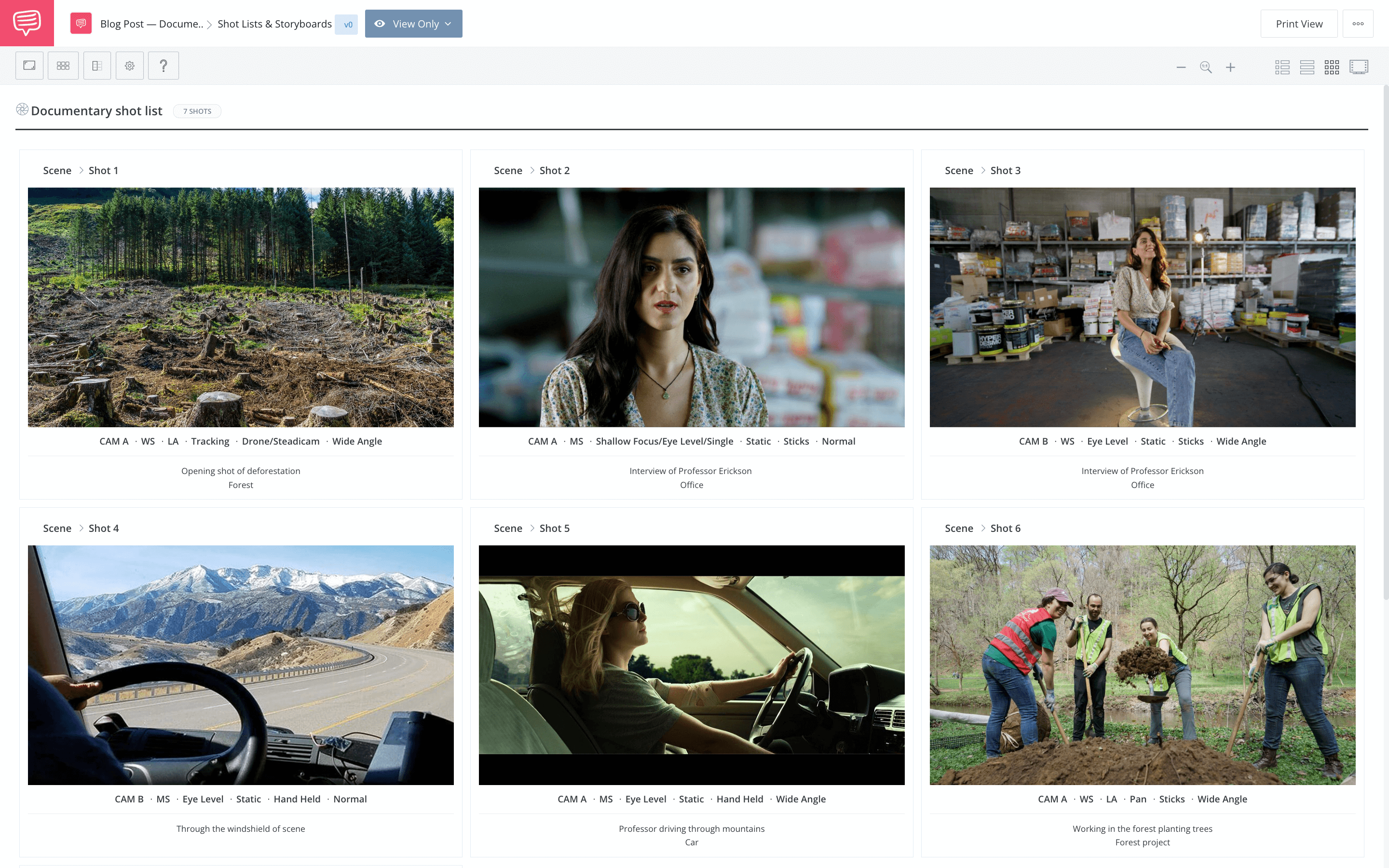It is common practice to create a shot list when preparing to shoot a narrative film. What about documentaries? Documentaries are a whole different type of project than narrative film. This does not, however, mean that they would not benefit from shot lists. It just means that documentary shot lists must be created to best serve your documentary’s needs. Let’s take a look at how to create a documentary shot list and how it can benefit your project.
Creating a Shot List for Documentary
Review your outline
The pre-production process for a documentary film is quite different from the process for a narrative film. In narrative film, the screenplay is the foundational blueprint of the film.
In a documentary, the story and structure might change after shooting. The foundation, therefore, is a detailed outline that serves as a blueprint for the structure of the documentary.
Check out this video by Indy Mogul that lays out the process of creating a documentary, one of which is distilling your ideas into an outline.
How to Write & Produce a Documentary : Indy News
Documentaries can often be unscripted and change dramatically during or after shooting. This does not mean, however, that you don’t need a shot list.
A general shot list will give you the blueprint to capture the shots you need to tell a story. Review this outline to understand what shots you will need to add to your shot list.
The shots you will need will depend on the type of documentary you are shooting. It’s important to thoroughly review your outline to understand what type of A-roll and B-roll to shoot. Your outline will also inform you about the interviews or events you will need to shot list.
Shot List for Making a Documentary
Creating the shot list
Once you have informed yourself on the details of the documentary outline, it’s time to start creating the shot list. Go through your outline and visually picture the sequence of the documentary.
For each shot that comes to mind, quickly write down a shot number and a shorthand description of the shot. For example, this could be:
Shot 1: Interview of professor
Shot 2: Wide shot of forest
Shot 3: Professor hiking through forest.
Once you have a rough list of these shots from your outline, bring them into a shot listing software. The most efficient and effective way to shot list is to utilize softwares like StudioBinder’s free shot listing app.
Here is a demonstration of how to utilize the app to make a shot list.
How to Make a Shot List • Subscribe on YouTube
As you can see, the app enables you to create a shot list and distinguish shot details from camera equipment to locations to compositions. This is important in a documentary where shot types vary greatly.
We used StudioBinder to create our own shot list of a spec doc about deforestation. Click the image below to view, explore, and download a PDF to use as a shot list template for your next documentary.
Let’s take a look at the process of creating this shot list and the things to consider when listing each shot. We’ll also talk about which shot details are most important to distinguish specifically in a documentary and why.
Documentary Shot List Template
1. Distinguish the camera
One of the most common types of shots in a documentary is the interview. In almost every interview, it is a good idea to have an A camera and a B camera to cut between and give you the ability to edit your interview. When shot listing an interview shot, you must first define which camera the shot is describing.
When you add a new shot in your StudioBinder shot list, click the “Camera” option and select the appropriate camera.
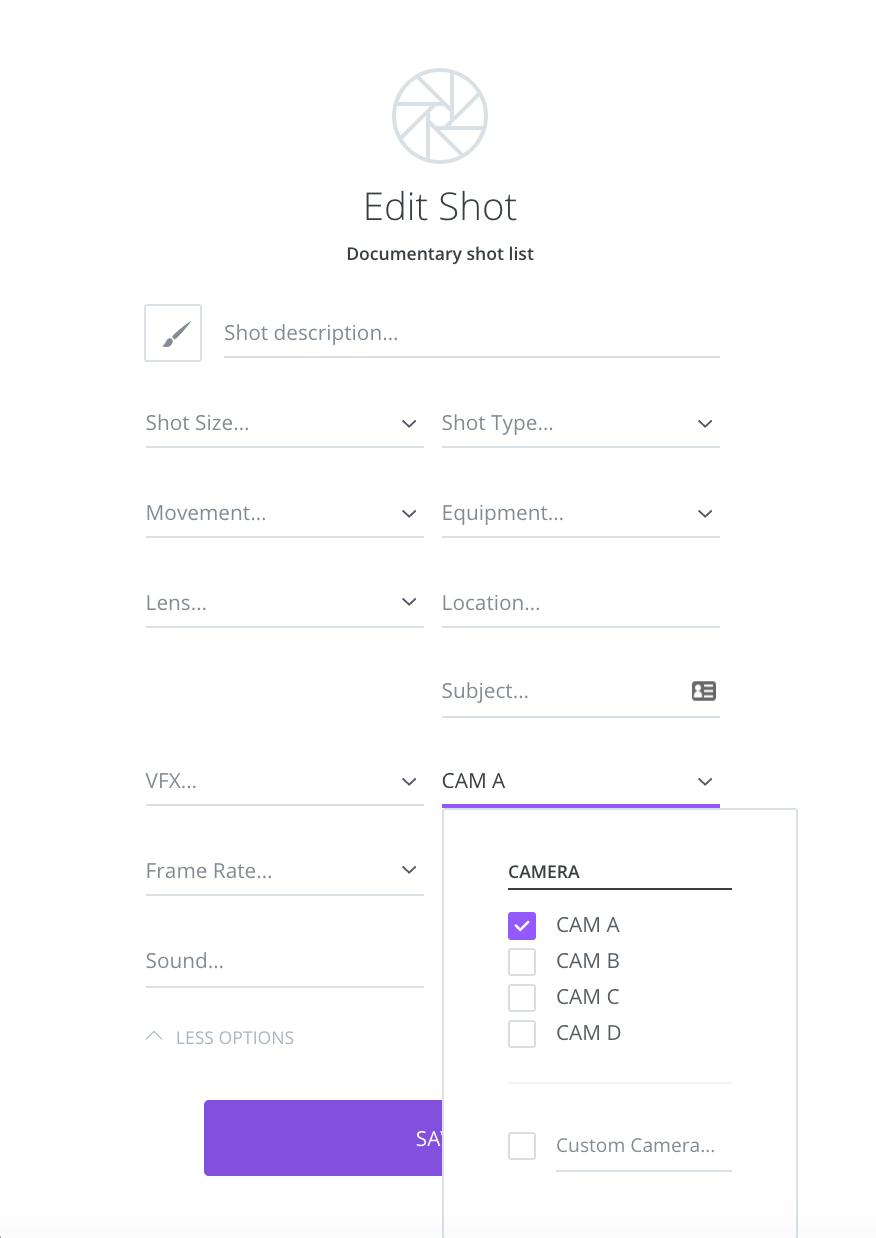
Distinguish the camera
Even if your documentary does not have any interviews, many documentaries still use multicam setups. When shot listing, it’s important to distinguish which camera you are creating a shot for.
Documentary Shot List Example
2. Describe the shot’s content
There are various types of shots that go into creating a documentary. Interviews, A-roll, B-roll, events, and archival footage are only a few types of shots that are used in documentaries.
It’s important to describe your shot in the “Shot description” section.
This can be the event you are shooting, the person you are interviewing, a description of a location, or any visual description of the shot.
The shot’s description is especially important if you don’t plan to attach any visuals to your storyboard.
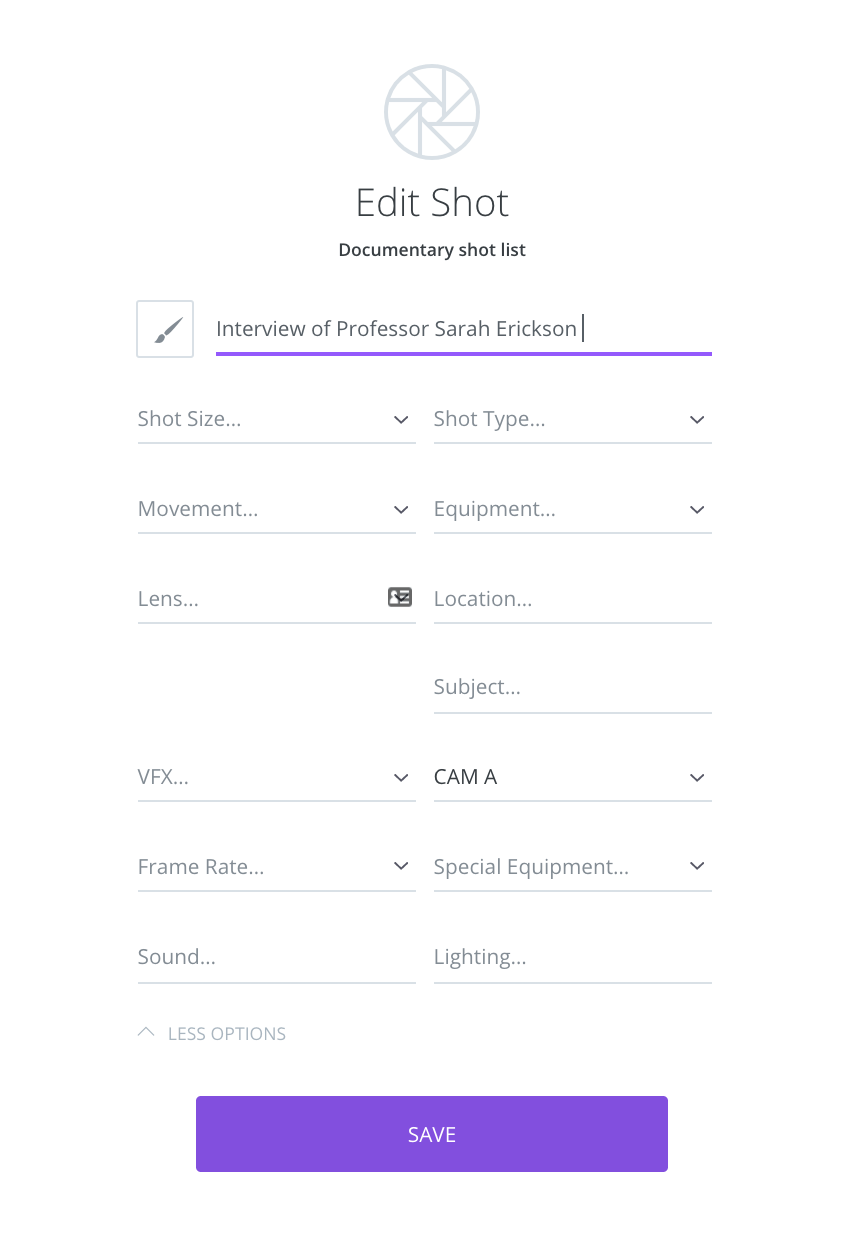
Shot description
The shot description is where you can be most detailed about the content of the shot. Try not to describe composition in the shot descriptions since the composition can be distinguished using other shot categories.
Related Posts
Shot List Tutorial
3. Choose the Shot Size
The next piece of information you will need to clarify is which type of shot sizes you will be using. Again, this is important for interviews where the A cam might capture a wide shot of the subject while the B cam simultaneously captures a close up shot.
Simply select the “Shot size” category and choose from various types of close-ups, medium shots, and wide shots. If you do not find the shot type you will be using, you can describe it manually in the “Custom Shot Size” section.
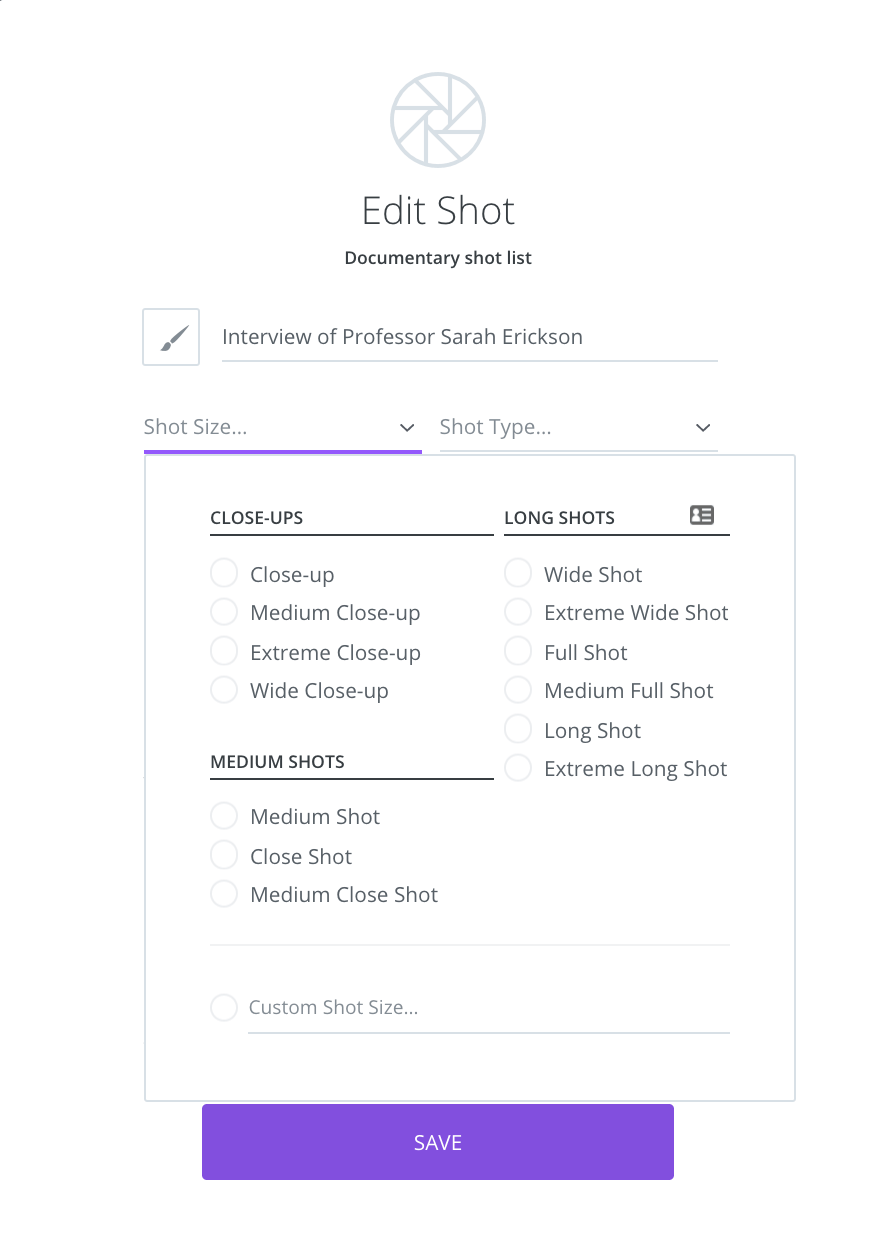
Shot size types
Documentaries use a variety of different types of shot sizes. If you need a refresher on what these different shot sizes mean and how they visually look, check out our shot size video breakdown below.
Ultimate Guide to Camera Shots • Subscribe on YouTube
Distinguishing the shot size is important for any shot you will be shooting in your documentary. When shooting documentaries, you will probably not have the luxury to reshoot a specific moment.
Because of this, it’s important to shot list the shot size so that you capture a scene exactly how you envision it.
Creating a Shot List for a Documentary
4. Describe the shot type
Now that you’ve described the shot’s content and size, it’s time to describe what kind of shot it is visually. This means clarifying the shot’s camera angle, framing, and depth of field.
All of which can be noted under the “Shot Type” section.
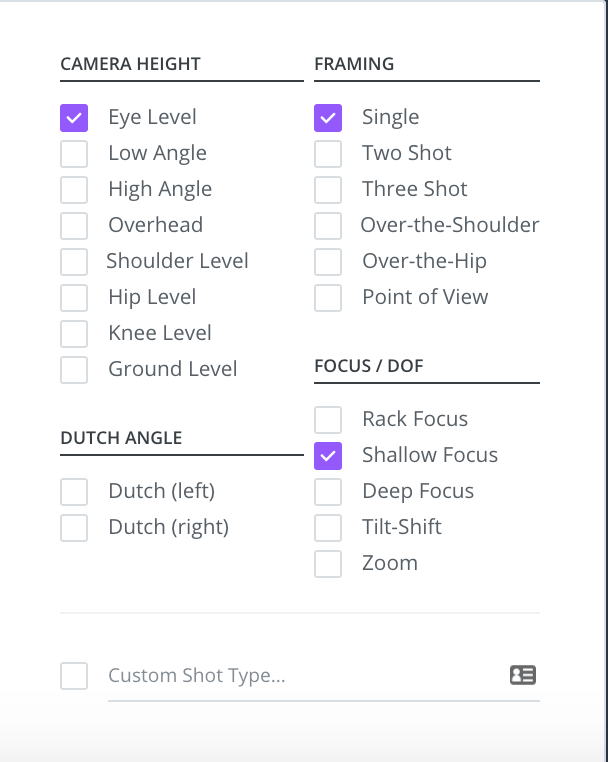
Shot type
This section is probably more relevant for interviews where you have more time to compose a shot. When it comes to freestyle, guerrilla filmmaking, these details are always subject to change.
Documentary Shot List Template Tutorial
5. Select your camera lens
Once you know the shot size and shot type, you’ll be informed enough to select the type of camera lens that will capture the shot. Choosing your camera lens’ focal length will help you achieve these visual effects that you desire.
Take a look at our video breakdown of the different types of camera lenses there are to choose from.
Ultimate Guide to Camera Lenses • Subscribe on YouTube
Even if you are shooting with a zoom lens as many documentary filmmakers do, you can note this in your shot list. If you plan to shoot with a prime lens at a fixed focal length, you can note this in your shot list too.
Related Posts
What to Include in Shot List
6. Determine your equipment
The on the go type of shooting that documentaries require entails the use of various camera rigs. Interviews may be shot on tripods, but shooting on location may require a Steadicam. Clarifying what types of camera equipment you will use for a shot is an important part of creating a documentary shot list.
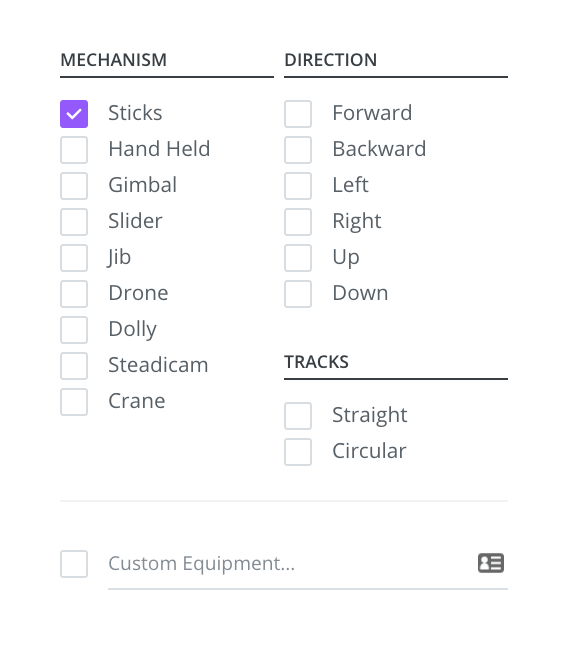
Shot listing camera equipment
Documentary shoots can be very limited in time. Noting what equipment you will be using in your shot list will better prepare you for your shoot and make you more efficient.
Completing a Shot List Tutorial
7. List the Location
Finally, list the location of the shot in your documentary shot list. This is important because interviews are often shot in different locations. Various event shoots will also have different locations and listing them in your shot list will keep you organized and prepared.
Creating a documentary shot list will not only help you envision the documentary that you want to create, but will help you communicate these ideas to the rest of the production.
Documentaries are often shot with multiple cameras on the fly. Even if every shot on the shot list isn’t captured or shots are taken that aren’t on the shot list, creating one will help give you and your team a clear idea of what you are trying to capture.
Up Next
How to Make a Documentary
Creating a documentary shot list is only one component of creating a documentary. In our next article, we lay out a step-by-step guide for creating a documentary from writing a treatment to doing research to creating a production schedule.
Up Next: Doc Filmmaking Explained →
Showcase your vision with elegant shot lists and storyboards.
Create robust and customizable shot lists. Upload images to make storyboards and slideshows.

